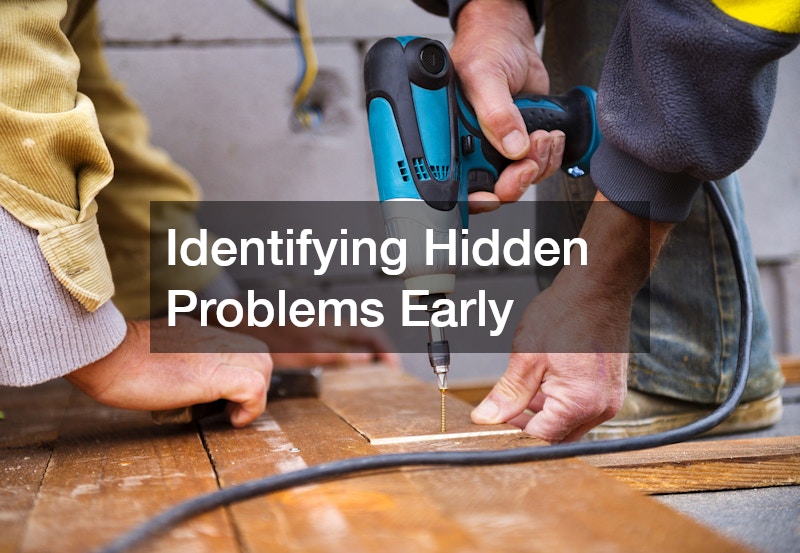Renovating an entire home can seem overwhelming at first. From identifying hidden issues to upgrading essential systems, a whole-home renovation involves careful planning and coordination. Whether you’re updating an older house or designing a modern living space from the ground up, understanding each critical step is key to achieving a successful and satisfying renovation.
This guide will walk you through the essential elements of a whole-home renovation, offering practical advice on everything from leak detection and heating system maintenance to outdoor enhancements and utility upgrades. Each aspect plays a vital role in not only beautifying your home but also protecting it from future damage and ensuring it functions smoothly for years to come.
A comprehensive whole-home renovation doesn’t just focus on aesthetics. It involves identifying and addressing hidden problems early before they worsen, upgrading crucial systems such as heating, cooling, and water utilities, and improving outdoor areas to increase curb appeal and property value. Attention to these details can save money in the long run, prevent costly repairs, and create a comfortable living environment tailored to your needs.
Whether you’re a first-time renovator or someone with experience looking for a fresh perspective, this guide covers the foundational topics that will help you plan confidently. From leak detection service tips to advice on installing a new AC system, we’ve got you covered. Let’s dive into the key stages of your whole-home renovation journey.

Identifying Hidden Problems Early
One of the most critical steps in any whole-home renovation is uncovering hidden issues that might not be obvious at first glance. Problems like water leaks, structural damage, or outdated wiring can escalate quickly if left untreated. Starting with a professional leak detection service is a wise investment to identify moisture problems before they cause mold growth or structural weakening.
Leak detection technology has advanced considerably, allowing experts to locate hidden leaks behind walls, under floors, or beneath your roof without destructive measures. Early detection ensures that repairs can be made promptly, preventing more extensive damage during the renovation process.
Incorporating leak detection early in your renovation timeline saves you from surprise repairs and project delays. It allows you to budget accordingly and address essential repairs before cosmetic upgrades begin. When planning a whole-home renovation, don’t overlook this crucial diagnostic step—it’s the foundation for a successful and safe remodeling project.
Maintaining Your Home’s Heating System
Heating systems are the heart of a comfortable home, especially in cooler climates. As part of your whole-home renovation, evaluating and maintaining your heating system should be a top priority. Over time, heating units can lose efficiency due to wear and tear, causing higher energy bills and uneven heating.
Scheduling heating repair services early on helps identify malfunctioning components such as faulty thermostats, cracked heat exchangers, or clogged filters. A thorough inspection will ensure your system operates safely and efficiently throughout the renovation and afterward.
When planning your renovation, consider upgrading to a more energy-efficient heating system if your current one is outdated. Modern heating solutions can significantly reduce energy consumption, improve indoor air quality, and provide better temperature control. Maintaining your heating system during the renovation also minimizes disruptions and keeps your home comfortable as construction progresses.
Enhancing Your Outdoor Spaces
The exterior of your home is just as important as the interior when it comes to a whole-home renovation. Thoughtful landscape design can transform your yard into a beautiful, functional space that complements your home’s style and increases its value.
Landscape design involves more than planting flowers or trees. It requires a strategic plan that considers soil quality, sunlight, drainage, and the flow of foot traffic. Adding features like patios, walkways, and outdoor lighting can create inviting spaces for relaxation and entertaining.
Integrating landscape design early in your renovation ensures that outdoor improvements coordinate seamlessly with the interior upgrades. For example, if you’re installing new windows or doors, planning your garden layout to maximize views and natural light enhances the overall experience. Working with a professional designer can help you create a cohesive look and make the most of your outdoor environment.

Protecting Your Home from Weather Damage
One of the most vulnerable parts of your home during a renovation is the roof. Investing in reliable roofing services is essential to protect your property from weather damage such as leaks, wind, hail, or snow.
Your roof acts as the first line of defense against the elements, so inspecting it before starting renovation ensures it can withstand potential stresses during construction. Roofing experts can assess the condition of shingles, flashing, gutters, and insulation, recommending repairs or replacements if necessary.
Upgrading roofing materials during your renovation can also improve energy efficiency by better insulating your home and reflecting heat. Consider modern roofing options like metal, architectural shingles, or cool roofs designed to reduce cooling costs.
Remember that a sturdy roof prevents moisture infiltration that could damage both old and new renovation work. Proper maintenance and timely roofing services are indispensable components of a whole-home renovation plan.
Upgrading Essential Home Utilities
Water heaters are often overlooked during renovations but are critical to everyday comfort. Replacing an old or inefficient unit with a modern water heater can increase energy savings and provide a consistent hot water supply.
When planning for water heater replacements, consider options such as tankless systems, which heat water on demand and reduce standby energy loss. These systems can be integrated smoothly into your renovation, saving space and improving your home’s energy profile.
A whole-home renovation is the perfect opportunity to upgrade your plumbing infrastructure alongside your water heater. Ensuring pipes, valves, and fittings are up to code and in good condition supports the longevity of your investment.
By modernizing your water heating system during your renovation, you contribute to a more sustainable and comfortable household.
Keeping Your Waste Systems Functional
A fully functioning waste disposal system is critical for any home renovation. Neglecting your septic system can lead to unpleasant backups, health hazards, and costly repairs down the line.
Scheduling a professional septic tank cleaning service early in your renovation timeline is essential to maintain system efficiency. Regular cleaning prevents sludge buildup, which can clog drain fields and cause failures.
During your whole-home renovation, it’s a good idea to inspect the entire septic system, including pipes and drainage areas. Coordinating this with other plumbing upgrades ensures a comprehensive approach to waste management.
Maintaining your septic system safeguards your investment and keeps your home safe and hygienic throughout the renovation process.

Addressing Roof Issues Promptly
Even if your roof has passed initial inspection, it’s vital to promptly address any issues that arise during the renovation. Small leaks or damaged shingles can worsen quickly, especially during construction when your roof may be exposed.
Engaging reliable roof repair services helps fix problems immediately, protecting your home and ongoing renovation work. Quick repairs minimize water intrusion that could damage walls, insulation, and flooring.
Your roofing contractor can also advise on improvements to extend the life of your roof, such as upgrading ventilation or adding protective coatings. Keeping your roof in excellent condition is a key step in preserving your home’s structural integrity during a whole-home renovation.
Improving Driveways and Walkways
Functional and attractive driveways and walkways contribute significantly to your home’s curb appeal and safety. They are often the first features guests and passersby notice, setting the tone for the entire property. Over time, however, these surfaces are subjected to heavy foot traffic, vehicle weight, weather exposure, and natural wear and tear. This can lead to cracks, potholes, uneven surfaces, and drainage issues, all of which not only detract from the home’s appearance but also pose safety hazards. Tripping hazards, water pooling, and erosion can create dangerous conditions for residents and visitors alike, making repair or replacement a necessary part of any comprehensive renovation.
Investing in professional paving services as part of your renovation ensures that your driveways and walkways are not only durable but also visually appealing. Professionals can recommend the best materials and installation methods suited to your climate, soil type, and usage patterns. Modern paving options like stamped concrete offer the look of natural stone or brick but with enhanced durability and lower maintenance. Permeable pavers, another innovative choice, allow rainwater to seep through the surface, reducing runoff and promoting groundwater recharge. These materials improve drainage and minimize water damage to your property while adding a unique design element.
When planning your paving upgrades, consider how these paths connect with key areas such as entrances, gardens, patios, and outdoor living spaces. A well-thought-out, cohesive layout not only supports ease of access but also ties together different parts of your property visually. Smooth transitions between paved areas and landscaping features enhance flow and create inviting outdoor environments. Additionally, adding features like lighting, edging, or contrasting textures can elevate both the functionality and style of your driveways and walkways.
Well-maintained driveways and walkways are a practical and beautiful addition to your whole-home renovation project. Beyond aesthetics, they improve property safety, increase resale value, and contribute to your home’s overall curb appeal. By selecting quality materials and professional installation, you ensure that these surfaces will stand up to daily use and weather conditions for many years, complementing the other upgrades made during your renovation.
Ensuring Safe Water Supply
Many homes rely on private wells for their water supply, making well maintenance a critical aspect of homeownership that is often overlooked until problems arise. Unlike municipal water systems, private wells require regular inspections and upkeep to guarantee that the water remains safe, clean, and reliable. During a whole-home renovation, scheduling a comprehensive well service checkup is a crucial step that homeowners should not neglect. Renovations often involve changes to plumbing, landscaping, or the foundation that can impact your well system’s operation, so ensuring it is functioning optimally before and during the project helps prevent unexpected complications.
Professional well services typically include a thorough inspection of the well pump, which is the heart of the water supply system. Technicians check for wear, corrosion, or electrical issues that could cause pump failure or inefficient operation. Water quality testing is another essential component of well service. This testing screens for contaminants such as bacteria, nitrates, heavy metals, and other potentially harmful substances that can affect your family’s health. If contaminants are found, well cleaning or treatment may be necessary to restore safe drinking water. Additionally, the well system itself may need cleaning to remove sediment buildup or debris that can reduce water flow and pressure.
Incorporating well maintenance into your whole-home renovation plan is an effective way to avoid sudden water shortages or contamination issues that could disrupt both construction and your household’s daily life. Maintaining a clean and efficient well system supports overall health by providing safe drinking water free from harmful pollutants. It also prevents damage to plumbing fixtures and appliances that rely on a steady, clean water supply.
Prioritizing well service upgrades can be the difference between a smooth renovation process and costly water problems later on. Addressing well issues proactively reduces the risk of water interruptions, costly emergency repairs, and potential damage to your renovated home. Including this step in your renovation plan contributes to the longevity, safety, and comfort of your living environment, making it a smart investment for the future.

Optimizing Your Cooling System
Just as heating is vital in colder months, a properly functioning cooling system ensures comfort during warmer seasons. Especially in regions that experience hot summers, having reliable air conditioning is essential for maintaining a comfortable indoor environment. Installing or upgrading an air conditioning unit is an important consideration in any whole-home renovation, as it can dramatically improve your home’s livability. An outdated or inefficient cooling system may struggle to keep up during peak temperatures, leading to uneven cooling, higher energy bills, and increased wear on the equipment. Addressing your cooling needs during a renovation allows you to select the best system suited for your home’s unique requirements, ensuring consistent comfort throughout your living spaces.
Professional AC installation allows you to select from a variety of energy-efficient models designed to meet your home’s size and layout. Modern air conditioning systems offer advanced features such as programmable thermostats, which enable you to set schedules that optimize cooling based on your daily routine. Zoning capabilities allow different rooms or areas of the house to be cooled independently, improving comfort while reducing energy waste. This level of customization not only keeps your living spaces at ideal temperatures but also helps lower utility costs by cooling only occupied areas. Additionally, many new AC models are designed to operate quietly and with improved filtration systems, which can enhance indoor air quality—a benefit that is especially valuable for households with allergy sufferers or respiratory conditions.
Integrating your cooling system upgrade with other renovation tasks, such as window replacement or insulation improvements, maximizes energy savings and overall comfort. For example, installing energy-efficient windows can reduce heat gain from outside, easing the burden on your AC system. Upgrading insulation in your walls, attic, and crawl spaces helps maintain cool air inside, preventing it from escaping. Coordinating these improvements as part of a whole-home renovation creates a more efficient, comfortable environment and helps you avoid costly energy waste. Working with professionals who understand how these systems interact ensures that your cooling system is sized and installed properly and that your home’s envelope supports optimal temperature regulation.
A well-planned AC installation not only boosts your home’s livability but also adds long-term value to your property. Potential homebuyers view modern, efficient cooling systems as a significant asset, which can increase market appeal and resale price. Moreover, reducing energy consumption contributes to lower greenhouse gas emissions, aligning your home with sustainability goals.
Planning a whole-home renovation involves far more than aesthetic updates. From early leak detection and heating system maintenance to landscaping, roofing, and utility upgrades, each step plays an essential role in creating a safe, efficient, and beautiful home. Paying attention to these often-overlooked systems ensures your renovation supports a comfortable, healthy lifestyle for years to come, making your home a true haven regardless of the season.
By identifying hidden problems early, you can prevent costly repairs and delays, ensuring a smoother renovation experience. Maintaining and upgrading heating and cooling systems improves comfort and energy efficiency, while outdoor enhancements and protective roofing services safeguard your investment.
Don’t overlook essential utilities like water heaters, septic tanks, and wells—these systems form the backbone of your home’s daily functionality and comfort. They often operate behind the scenes, but without proper maintenance and timely upgrades, they can lead to significant disruptions and costly repairs. During a whole-home renovation, giving these critical systems the attention they deserve ensures that your home runs smoothly and efficiently long after the project is complete. Similarly, prompt roof repairs not only prevent water damage and protect the structural integrity of your house but also safeguard the investments you make inside. Addressing issues such as missing shingles, leaks, or poor ventilation early can save you from major headaches down the road. In addition, improving driveways and walkways boosts curb appeal, making your property more inviting and increasing its market value. Well-planned paving repairs or replacements improve safety by eliminating tripping hazards and enhance drainage, preventing water pooling and erosion.
A carefully planned whole-home renovation balances functionality with style, focusing on long-term benefits rather than quick fixes or purely cosmetic changes. This approach helps you create a living space that is not only beautiful but also durable, energy-efficient, and tailored to your family’s needs. Renovations that prioritize quality materials, up-to-date systems, and smart layouts offer comfort and convenience for years to come. Collaborating with qualified professionals—whether they are contractors, designers, or specialized technicians—throughout the process is key to achieving the best results. Their expertise ensures that each aspect of your renovation is completed correctly, meets safety standards, and fits your vision and budget.
By following this guide, you can approach your whole-home renovation with confidence, equipped with the knowledge to make informed decisions and prioritize the most impactful improvements. Whether your home has decades of history or you’ve just purchased it, a strategic renovation transforms it into a comfortable, efficient, and stunning living space. Thoughtful planning, professional execution, and attention to detail will not only increase your property’s value but also enhance your family’s everyday enjoyment. Taking the time to do it right means your home will serve as a safe, beautiful sanctuary for many years to come.










